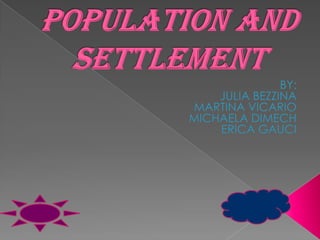
Population and Settlement Factors
- 1. Population and Settlement BY: JULIA BEZZINA MARTINA VICARIO MICHAELA DIMECH ERICA GAUCI
- 2. Factors on populationFactors on population Factors affecting population density Environmental and human factors affect the spread of people across the world. The Brahmaputra river in India Factors attracting settlement Temperate climate, e.g. the UK. Low-lying flat fertile land, e.g. the Bangladesh Delta. Good supplies of natural resources, e.g. building resources. The Sahara Desert Factors discouraging settlement Extreme climates, e.g. Sahara Desert. Mountainous or highland areas, e.g. the Scottish Highlands. Dense vegetation, e.g. the Amazon Rainforest.
- 3. If we group and classify a number of settlements according to their size and shape the result is settlement hierarchyPyramid showing relationship between population and servicesAs you move up the hierarchy, the size of the settlement and the distance between similar sized settlements increases. As you can see from the diagram below, there are more cities than conurbations, more towns than cities and more villages than towns.The number of services that a settlement provides increases with settlement size. Small settlements will only provide low order services such as a post offices, doctors and newsagents. Large towns, cities and conurbations will provide low and high order services such as leisure centres, chain stores and hospitals.Larger settlements and conurbations have a much larger sphere of influence than smaller ones. This means they attract people from a wider area because of the facilities they offer. Cities such as London have a global sphere of influence, whereas a small hamlet or village may only have a sphere of influence of a couple of kilometres.Services such as department stores selling high order goods have a higher threshold than those selling low order goods such as newsagents. This means they need a higher number of people to support them and make them profitable, therefore they will only be found in larger settlements. It also means that there are fewer big department stores than small newsagents. The range of a service or product is the maximum distance people are prepared to travel to purchase it. The range of a newspaper is much lower than an item of furniture for example.
- 5. 1. Which of the following would be the best place to site a settlement? On a remote hillside away from streams and riversOn a low-lying stretch of fertile floodplainOn higher ground within easy reach of a riverAway from fertile land close to sources of rock 2. Which of these is NOT a function of a settlement? MultifunctionalA spa or seaside resortA market town or regional shopping centreCentral business district 3. What is a settlement hierarchy? The placement of settlements in order of importanceThe structure of a settlementThe function of a settlementThe site of a settlement 4. Which of the following is a high order service? NewsagentDepartment storeSupermarketBank